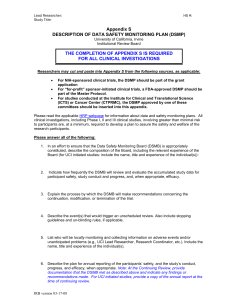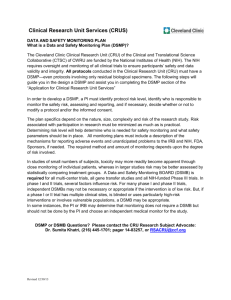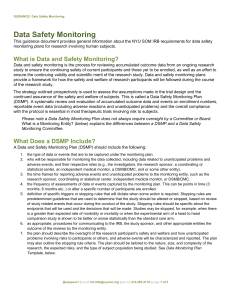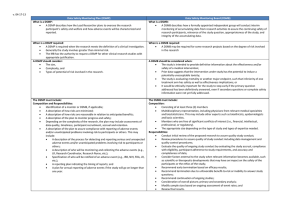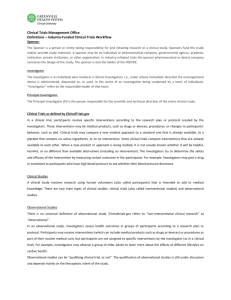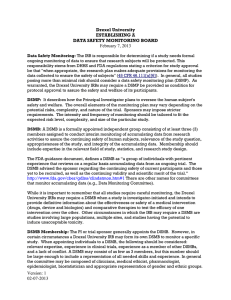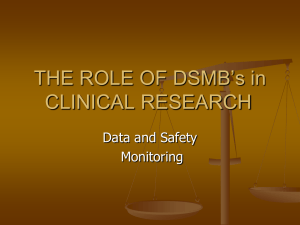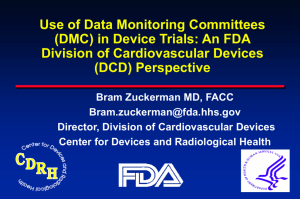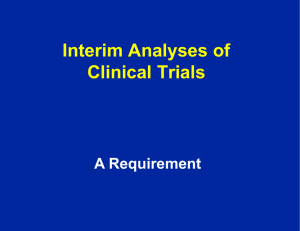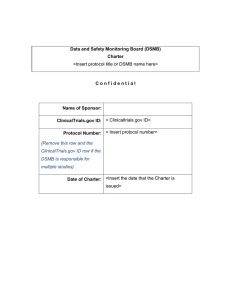data and safety monitoring plans
advertisement
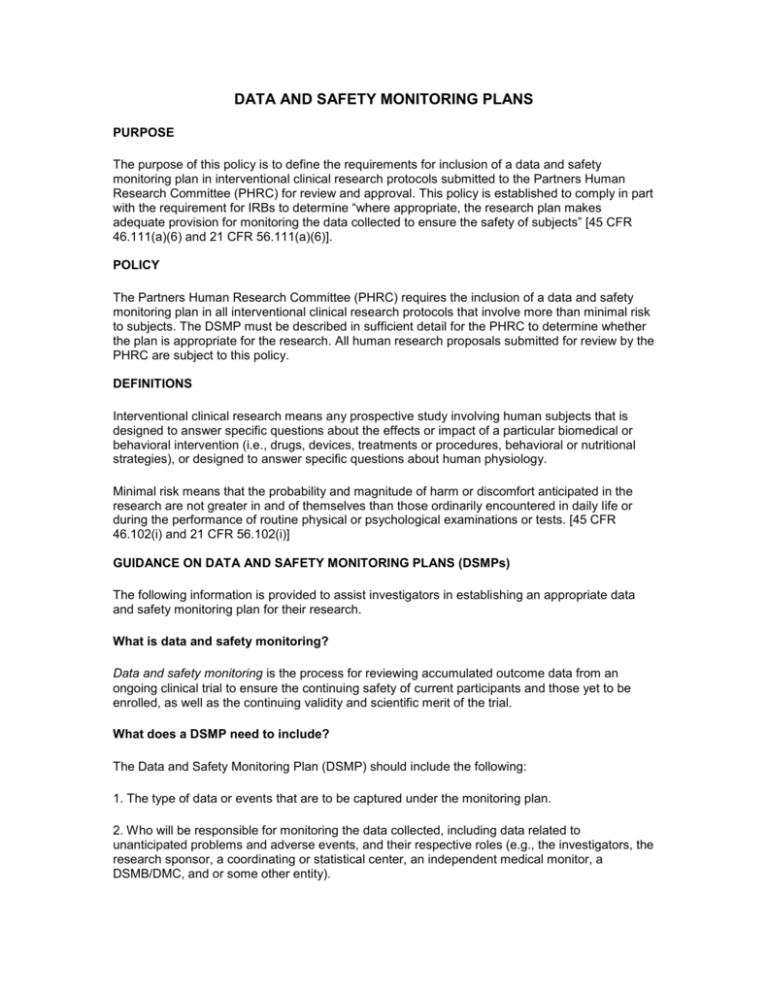
DATA AND SAFETY MONITORING PLANS PURPOSE The purpose of this policy is to define the requirements for inclusion of a data and safety monitoring plan in interventional clinical research protocols submitted to the Partners Human Research Committee (PHRC) for review and approval. This policy is established to comply in part with the requirement for IRBs to determine “where appropriate, the research plan makes adequate provision for monitoring the data collected to ensure the safety of subjects” [45 CFR 46.111(a)(6) and 21 CFR 56.111(a)(6)]. POLICY The Partners Human Research Committee (PHRC) requires the inclusion of a data and safety monitoring plan in all interventional clinical research protocols that involve more than minimal risk to subjects. The DSMP must be described in sufficient detail for the PHRC to determine whether the plan is appropriate for the research. All human research proposals submitted for review by the PHRC are subject to this policy. DEFINITIONS Interventional clinical research means any prospective study involving human subjects that is designed to answer specific questions about the effects or impact of a particular biomedical or behavioral intervention (i.e., drugs, devices, treatments or procedures, behavioral or nutritional strategies), or designed to answer specific questions about human physiology. Minimal risk means that the probability and magnitude of harm or discomfort anticipated in the research are not greater in and of themselves than those ordinarily encountered in daily life or during the performance of routine physical or psychological examinations or tests. [45 CFR 46.102(i) and 21 CFR 56.102(i)] GUIDANCE ON DATA AND SAFETY MONITORING PLANS (DSMPs) The following information is provided to assist investigators in establishing an appropriate data and safety monitoring plan for their research. What is data and safety monitoring? Data and safety monitoring is the process for reviewing accumulated outcome data from an ongoing clinical trial to ensure the continuing safety of current participants and those yet to be enrolled, as well as the continuing validity and scientific merit of the trial. What does a DSMP need to include? The Data and Safety Monitoring Plan (DSMP) should include the following: 1. The type of data or events that are to be captured under the monitoring plan. 2. Who will be responsible for monitoring the data collected, including data related to unanticipated problems and adverse events, and their respective roles (e.g., the investigators, the research sponsor, a coordinating or statistical center, an independent medical monitor, a DSMB/DMC, and or some other entity). 3. The time frames for reporting adverse events and unanticipated problems to the monitoring entity, such as the research sponsor, coordinating or statistical center, independent medical monitor, or DSMB/DMC. 4. The frequency of assessments of data or events captured by the monitoring plan, such as points in time or after a specific number of participants are enrolled. 5. Definition of specific triggers or stopping rules that will dictate when some action is required. Stopping rules are predetermined guidelines that are used to determine that the study should be altered or stopped, based on review of study related events that occur during the conduct of the study. Stopping rules should be specific about the endpoints that will be used and the decisions that will be made. Studies may be stopped, for example, when there is a greater than expected rate of morbidity or mortality or when the experimental arm of a head to head comparison study is shown to be better or worse statistically than the standard care arm. 6. As appropriate, procedures for communicating to the IRB, the study sponsor, and other appropriate entities the outcome of the reviews by the monitoring entity. What type of DSMP is appropriate? A Data and Safety Monitoring Plan should be tailored to the nature, size, and complexity of the research protocol, the expected risks of the research, and the type of subject population being studied. Appropriate DSMPs may fall anywhere along a continuum from monitoring by the principal investigator or group of investigators to the establishment of an independent Data and Safety Monitoring Board (DSMB)/Data Monitoring Committee (DMC). 1. Investigator The principal investigator could perform this function. This type of plan is appropriate when the study involves a small number of subjects; the study is conducted only at one site; and the range of possible study events that could have an important impact on the risks and benefits of research participants is narrow. In such cases, continuous monitoring of events by the investigator, and prompt reporting of toxicity to the IRB and, when applicable, the FDA, the NIH, or others, may be adequate. 2. Monitor/Monitoring Group A qualified and objective individual or group not directly involved with the design and conduct of the study (e.g., safety officer, designated Medical Monitor or Monitoring Group) could perform this function. These individuals may or may not be employees of Partners or the study sponsor. However, conflict of interest is an important consideration when employees of the study sponsor have the primary responsibility for monitoring data from the standpoint of scientific integrity and participant safety. This type of plan is often appropriate to monitor data and safety for clinical trials that involve: endpoints that are not serious irreversible events; an intervention (for example, to relieve symptoms) that is not high risk and the effects of which would not generally be so compelling as to ethically warrant early termination for effectiveness; short term treatments where effects are evaluated over periods of a few days to a few months; and a smaller number of subjects where the study is completed quickly and the risk can be adequately assessed through simple comparisons. In these studies, valuable secondary objectives such as characterization of the effect (i.e., magnitude, duration, time to response), assessment of the effect in population subsets, comparison of several doses/or comparison of the new product to an active control can be ethically pursued even when the conclusion regarding the primary efficacy outcome is clear. Early termination for effectiveness is rarely appropriate in such studies. First, the study may be essentially completed by the time any interim analysis to evaluate effectiveness could be undertaken. Second, the effectiveness of an intervention, for example, to relieve symptoms, would not generally be so compelling as to override the need to collect the full amount of safety data, or to collect other information of interest and importance that characterizes the effect. 3. Data and Safety Monitoring Board (DSMB)/Data Monitoring Committee (DMC) An independent Data and Safety Monitoring Board (DSMB)/Data Monitoring Committee (DMC) external to the trial organizers and investigators could perform this function. A DSMB/DMC is a formal committee that is established specifically to monitor data throughout the life of a study to determine if it is appropriate, from both the scientific and ethical standpoint, to continue the study as planned. In general, an independent DSMB/DMC is the most appropriate way to monitor data and safety for studies that involve: Large numbers of subjects where risk may better be assessed through statistical comparisons of treatment groups; Blinded study treatment groups where the validity and integrity of the study may be adversely affected by having an individual or group associated with the design and conduct of the study break the blind; Multiple clinical sites where there is a need for investigators to submit reports of adverse events to a central reporting entity, such as a coordinating center or statistical center, responsible for preparing timely summary reports of adverse events for distribution among the clinical sites, and to the IRBs; High risk interventions where death or severe disability is a major risk of research participation; and/or Controlled trials with mortality or major morbidity as a primary or secondary endpoint where increased morbidity or mortality may better be assessed through statistical comparisons of morbidity or mortality among treatment groups. DSMBs/DMCs are typically made up of individuals who have expertise in the field, experience in the conduct of clinical trials, and/or statistical knowledge, and who do not have any serious conflicts of interest, such as financial interests that could be substantially affected by the outcome of the trial, strong views on the relative merits of the interventions under study, or relationship with the sponsor or those in trial leadership positions that could be considered reasonably likely to affect their objectivity. DSMBs/DMCs meet at least annually or more often depending on the nature of the trial being monitored. DSMBs/DMCs can monitor the timeliness of accrual, the quality of data collection and management, and the accumulating outcomes to assure the safety of participants and the scientific integrity of the study. Regardless of data and safety monitoring plans by the sponsor or others, the principal investigator is ultimately responsible for protecting the rights, safety, and welfare of subjects under his/her care and for ensuring that the study is conducted at his/her investigative site in accordance with the IRB-approved protocol, and applicable regulations and requirements of the IRB. NIH Sponsored Research The NIH has established a policy that requires each of its Institutes and Centers (IC) to have a system for the appropriate monitoring of the conduct of clinical trials to ensure the safety of participants and the validity and integrity of the data for all NIH-supported or conducted clinical trials. Investigators must comply with monitoring requirements of the relevant funding agency in addition to those of the PHRC. The establishment of DSMBs is required for multi-site clinical trials involving interventions that entail potential risk to the participants. This would include, in most cases, phase III clinical trials. A phase III trial frequently compares a new treatment to a standard treatment or to no treatment, and treatment allocation may be randomly assigned and the data masked. These studies usually involve a large number of participants followed for longer periods of treatment exposure. While short-term risk is usually slight, one must consider the long term effects of a study agent or achievement of significant safety or efficacy differences between the control and study groups for a masked study. An IC may require a DSMB to perform monitoring functions. This DSMB would be composed of experts relevant to the study and would regularly assess the trial and offer recommendations to the IC concerning its continuation. For more information on NIH Policy, see below: The NIH Policy for Data and Safety Monitoring Further Guidance On A Data And Safety Monitoring For Phase I And Phase II Trials
